| On this page |
Overview ¶
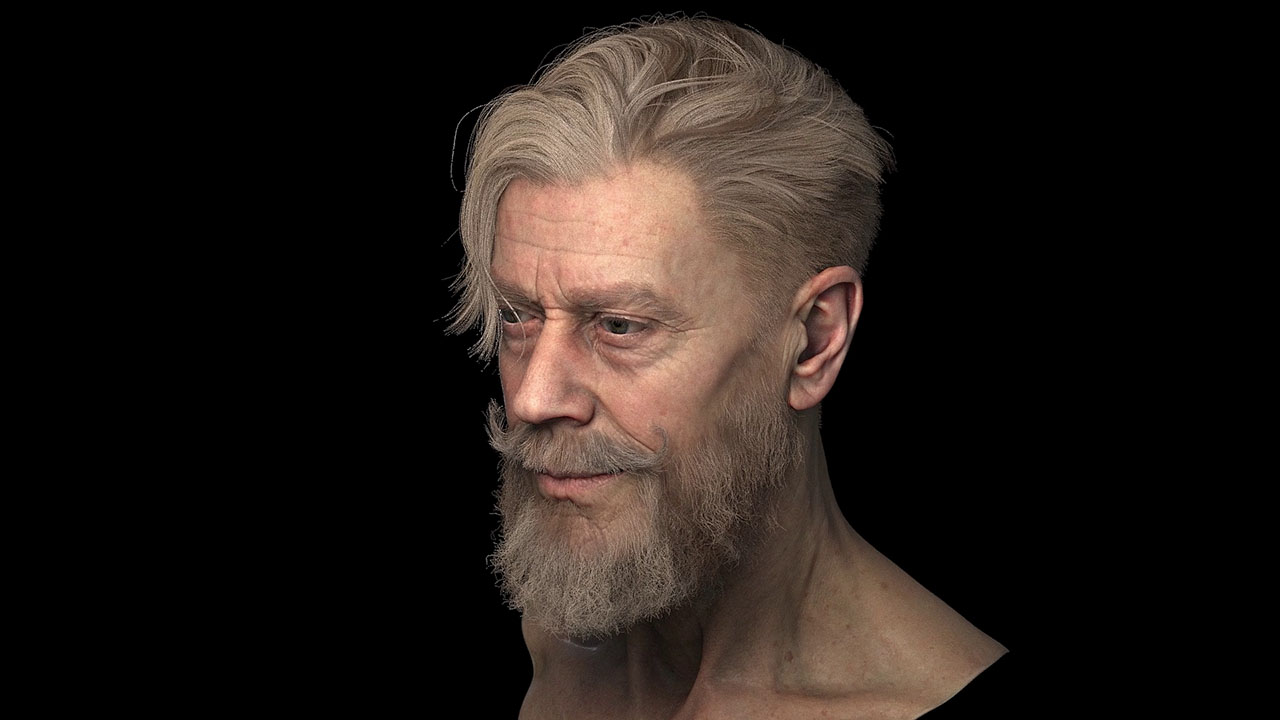 Image by Andriy Bilichenko
Image by Andriy Bilichenko
The Groom shelf tool on the Guide Process tab creates a
Guide Groom SOP and switches the viewport to the grooming state. This tool, combined with the new grooming radial menus, allow you to quickly and interactively draw and style fur.
Note
Files from earlier Houdini versions with the Hair Generate SOP node can still be used. Plug the first output of the Hair Generate SOP node to the first input of the Guide Groom SOP node to make it work.
Grooming radial menu ¶
When using the Guide Groom SOP, make sure to switch to the Grooming radial menu from the top menu bar. This menu lets you quickly switch tools options in the viewport, and is the recommended workflow when using this node.
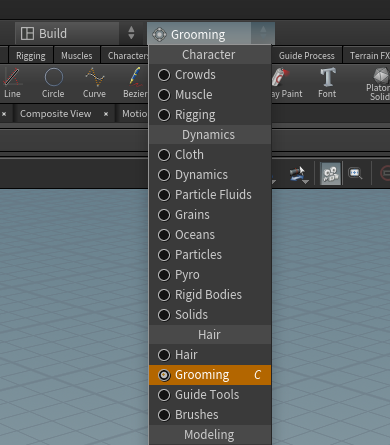
After switching to the Grooming radial, you can open it by pressing C. This brings up a menu that contains all the Tool options for the Guide Groom SOP, and reflects the options available in the Tool dropdown parameter on the node. It’s a quick way to switch between the options on this node.
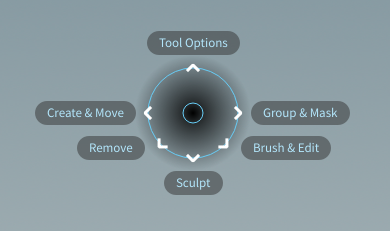
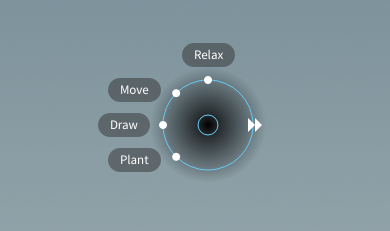
For example, if you hover your mouse over Create & Move, you will see the 4 options available for creating and moving hair. You can either choose one, or navigate back to the previous level by hovering your mouse over the double arrows.
Each Tool has a Tool Options menu that is unique to that mode. For example, the tool options available in Draw mode are different than the ones available in Plant mode.
Working with brushes ¶
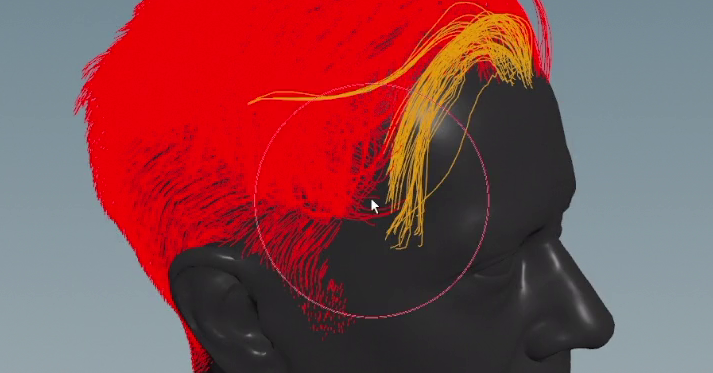
Many tools of the Guide Groom SOP use brushes, for example Plant, Sculpt, Smooth, or Brush. When Surface Brush is turned off in the parameter section, you are in screen mode. Most tools are able to work in both screen and surface mode. In surface mode, the brush will follow the outlines of the object you're working on. In screen mode, the brush is a plain projection on the viewport.
Brush size is indicated through a red circle in the viewport. You can change brush size interactively by using the , or numerically by changing Screen Radius or Object Radius in the node’s parameter section. Some tools like, for example, Plant Work can only be used in Surface Brush mode. In this case, brush size can be controlled through Object Radius.
Softness adds a falloff to the brush. A value of 0 creates a hard brush with no falloff.
Creating and moving hair ¶
The controls for creating and moving hair are located in the Create & Move section of the Grooming radial menu. If you hover over this option with your mouse, it will take you to a sub-menu where you can choose to Draw, Plant, Move, or Relax hair.
Tip
You can select the Guide Groom SOP and choose the appropriate entry from the Tool menu. Most of the SOP’s options are also available in the parameter editor. The radial menu just provides a quick way of switching between them.
Note
Modifications on hair will only be applied to selected strands. Hold the S key while selecting multiple hairs in the viewport. When you hover over the hairs they will turn blue, and orange once selected. Alternatively, enter a single number or a range in the Guide Groom node’s Group attribute.
Drawing hair ¶
The Draw option lets you interactively draw guides from your perspective. By default, the guides are aligned to your view (projected into screen space) and will all be the same orientation. Each guide hair also has a default Segment Count of 8. This is typically sufficient for most short hair or fur, since having too many points per strand could affect performance.
| To... | Do this |
|---|---|
|
Draw hair in screen space |
|
|
Draw hair on the skin of a character |
|
|
Change the default number of segments on a strand of hair |
|
|
Change the default number of segments on all hairs |
Update the Segment Count parameter in the Brush Options section of the This will save your preference for all future hairs you draw. |
|
Automatically create more segments as you draw longer curves |
|
|
Spread out points evenly along a curve |
|
|
Draw a parting line to separate groups of hairs |
|
Planting hair ¶
The Plant option lets you interactively place hairs based on the closest existing curves. It will create these new guide hairs in the same orientation and interpolate the length based on the surrounding hairs.
| To... | Do this |
|---|---|
|
Plant single guide hairs |
|
|
Plant multiple guide hairs |
|
Moving hair ¶
The Move option allows you to slide the roots of selected hairs along the surface without changing the orientation. This is very useful when creating hairlines or facial hair on a character. Sometimes after sculpting hair, you may need to clean up areas like this to push hairs back into place.
| To... | Do this |
|---|---|
|
Move hairs at the root |
|
Relaxing hair ¶
The Relax option lets you push the roots of hairs apart if they're drawn too close together. It will try to spread the roots out evenly along the surface, so they're not too clumped together.
| To... | Do this |
|---|---|
|
Spread out hairs at the root |
|
Removing hair ¶
| To... | Do this |
|---|---|
|
Delete guide hairs |
|
|
Thin out patches of hair |
|
Sculpting hair ¶
The options in the Sculpt menu allow you to Smooth, Clump, Blur, Sculpt, and Sculpt with Physics.
| To... | Do this |
|---|---|
|
Brush hairs while maintaining the length |
Tip You can also select a single hair if you only want to brush one hair into place. |
|
Brush hairs while keeping their offset from each other |
|
|
Remove the kinks from jagged looking guide hairs |
|
|
Pull hairs together |
Tip This option is often used in combination with the Smooth option to create more natural looking clumps of hair. You can use the Smooth option to remove harsh bends in hairs as they're pulled into the clump. |
|
Average the direction and length of hairs |
|
|
Run a simulation on existing hairs |
|
Brushing and editing hair ¶
The options in the Brush & Edit menu are mostly designed to fine tune your sculpted hair or fix errors.
| To... | Do this |
|---|---|
|
Stretch and rotate hair |
|
|
Push hairs outside the collision object that have gotten stuck |
|
|
Rotate hair from the root without changing the shape |
|
|
Push hair away from the surface |
|
|
Straighten hairs |
|
|
Change the length of hairs |
|
Grouping and masking ¶
Groups are used to separate different parts of hair, for example eyebrows and eyelashes. You can use the Geometry Spreadsheet pane’s Primitives switch to control if the hairs have been added to a group.
The Name Attribute doesn’t have to be changed in most cases. It can be used to further subdivide groups, e.g. if you want to split eyebrows into grey and dark hair.
Masks let you define areas where hairs will appear. NOTE
A single hair or a selection of hairs can belong to more than one group.
| To... | Do this |
|---|---|
|
Adding hairs to a group through brushing |
|
|
Adding hairs to an existing group through selection |
|
|
Adding new hairs to an existing group |
|
|
Change the name of a hair selection |
|
Mirroring ¶
Turning on the Mirroring checkbox in the parameter editor will mirror existing hairs as well as any operations as they're applied. This can also be turned on and off by pressing ⇧ Shift + M in the viewport.
You can create, move, remove, sculpt, brush, and edit hairs on either side of the character and the changes with be reflected on both sides. Once mirroring is turned off, your changes will all be preserved on one side of the character, so you won’t lose any drawn hairs or edits regardless of which side was changed.
Transform handle ¶
This tool lets you stretch and rotate hair.
-
Select the hairs you want to stretch and rotate.
-
Right-click the selected hair and choose Select Tip(s).
-
Press C in the viewport to open the radial menu.
-
Hover your mouse over Brush & Edit and choose Transform Handle.
-
Use the transform handle to pull or rotate the selected hair.
Note
You can use this Transform Handle on any point in the curve (not just on the tips) to pull or rotate any portion of the hair.
Utilities ¶
Utilities are a convenient way to ease resampling, twisting, and mirroring. You will find specific parameters for each tool in the Guide Groom SOP node’s Utility options. Utilities can be applied to one or more groups of hair: If a group exists, add its name to the node’s Group field, and execute the utility.
Resample Utility ¶
This tool lets you change the number of intermediate points interactively. Choose the utility from the Guide Groom node’s Tool menu, and go to Utility options. There, choose a Segment Mode and make sure that Preview is turned on to get a life preview in the viewport.
Drag the appropriate segment slider to increase or decrease the number of points. For short hair, a small segment number is often sufficient. Long hair strands normally require more segments to appear smooth. You can also consider using group names to differentiate between long ans short hair, for example.
Click Apply to confirm your changes.
Twist Utility ¶
This tool lets you curl the entire set of hairs or a group. In the Guide Groom SOP node’s parameter section go to Utility Options. There, turn on Preview to monitor your actions in the viewport. Drag the Angle slider or enter a fixed value. Click Apply to confirm your changes.
Mirror Utility ¶
This utility lets you preview the mirroring process. Go the parameter section of the Guide Groom SOP node, and open Utility options. There, turn Preview on and off. This is useful if you want to evaluate the result of the mirroring process. In the Mirroring section you can find all associated parameters to adjust the result, as well as the Mirror Group field for restricting the process to selected groups.
In Utility options, click Apply to confirm your changes.